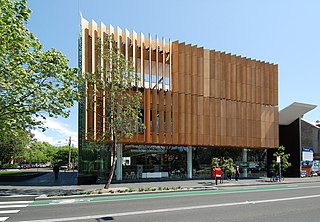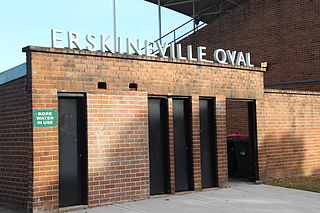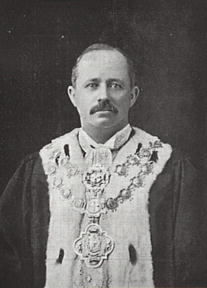
Darlinghurst is an inner-city suburb in the eastern suburbs of Sydney, New South Wales, Australia. Darlinghurst is located immediately east of the Sydney central business district (CBD) and Hyde Park, within the local government area of the City of Sydney. It is often colloquially referred to as "Darlo".

Surry Hills is an inner-east suburb of Sydney, in the state of New South Wales, Australia. Surry Hills is immediately south-east of the Sydney central business district in the local government area of the City of Sydney. Surry Hills is surrounded by the suburbs of Darlinghurst to the north, Chippendale and Haymarket to the west, Moore Park and Paddington to the east and Redfern to the south. It is often colloquially referred to as "Surry".

Oxford Street is a major thoroughfare in Sydney, New South Wales, Australia, running from the south-east border of the Sydney central business district to Bondi Junction in the Eastern Suburbs. Close to the CBD in particular, the street is lined with numerous shops, bars and nightclubs. After the 1980s, Oxford Street garnered a reputation as Sydney's primary nightclub strip and subsequently saw a large increase in the number of crimes committed in the area. However, the 2014 lockout laws saw many nightclubs close and the crime rate drop as Sydney's nightlife hubs moved to Darling Harbour and Newtown. The lockout laws ended in 2020 with a focus on small bars and restaurants. Many nightclubs reopened in 2021 especially around Taylor Square.

Kings Cross is an inner-eastern locality of Sydney, New South Wales, Australia. It is located approximately 2 kilometres east of the Sydney central business district, in the local government area of the City of Sydney. It is bounded by the suburbs of Potts Point, Elizabeth Bay, Rushcutters Bay and Darlinghurst.

Paddington is an upscale Eastern Suburb of Sydney, in the state of New South Wales, Australia. Located 3 kilometres (1.9 mi) east of the Sydney central business district, Paddington lies across two local government areas. The portion south of Oxford Street lies within the City of Sydney, while the portion north of Oxford Street lies within the Municipality of Woollahra. It is often colloquially referred to as "Paddo".

Russell Street is a main street and thoroughfare in the Melbourne central business district, Victoria, Australia. It runs roughly north-south and was laid out as a core feature of the Hoddle Grid in 1837.

The Eastern Distributor is a 4.7-kilometre-long (2.9 mi) motorway in Sydney, New South Wales, Australia. Part of the M1 and the Sydney Orbital Network, the motorway links the Sydney central business district with the south-east and Sydney Airport. The Eastern Distributor separates Sydney's Eastern Suburbs from Sydney's Inner-Southern Suburbs. The centre-piece is a 1.7 km (1.1 mi) tunnel running from Woolloomooloo to Surry Hills. Built as a build-own-operate-transfer project, it is 75.1% owned by Transurban.

William Street is a 1.4-kilometre-long (0.87 mi) major thoroughfare in Sydney, New South Wales, Australia. The street was named in honour of king William IV of the United Kingdom of Great Britain and Ireland upon its opening in 1834.

The City of Sydney Library network consists of nine branch libraries and two 'library links', located in Australia within the City of Sydney Council administrational area.

Erskineville Oval is a sporting venue in Erskineville, Sydney, New South Wales, Australia. Originally developed and opened in 1885 as Macdonaldtown Park, it was later renamed in 1892 to its current form with the municipality name change of the local government body. At approximately a capacity of 5000 spectators, previously 2000 Erskineville Oval was formerly an AFL venue as of 1903 when the NSW Australian Football League was founded. From 1913, the ground become a rugby venue as well, in which it has since hosted professional teams such as Newtown and the South Sydney Rabbitohs.

John Graham Knatchbull was an English naval captain and convict found guilty of murder in 1844. He was one of the earliest to raise in a British court the plea of moral insanity (unsuccessfully).

Mortimer William Lewis was an English-born architect, surveyor and public servant who migrated to Australia and became Colonial Architect in the colony of New South Wales from 1835 to 1849. Lewis was responsible for designing and overseeing many government buildings in Sydney and rural New South Wales, many of which are heritage listed.

Nellie Cameron, known as "The Kiss of Death Girl", was a notorious Sydney prostitute in the 1920s and 1930s, who was featured extensively in the 2011 Australian television mini-series Underbelly: Razor. Cameron was associated with the cocaine-fuelled ravages of the razor gang violence of that era, commonly associated with her contemporaries Tilly Devine and Kate Leigh, both criminal entrepreneurs who controlled much of Sydney's illegal sex industry and Sly-grog distribution during that period. Nellie Cameron received 73 criminal convictions during her life of crime, mainly for soliciting and vagrancy, and had the distinction of becoming the first woman in Australia to be convicted of consorting with criminals.

Sir Allen Arthur Taylor was an Australian businessman and New South Wales state politician who was Lord Mayor of Sydney, Mayor of Annandale and a member of the New South Wales Legislative Council.

The Darlinghurst Courthouse is a heritage-listed courthouse building located adjacent to Taylor Square on Oxford Street in the inner city Sydney suburb of Darlinghurst in the City of Sydney local government area of New South Wales, Australia. Constructed in the Old Colonial Grecian style based on original designs by Colonial Architect, Mortimer Lewis, the building structure was completed in 1880 under the supervision of Lewis's successor, James Barnet. It was added to the New South Wales State Heritage Register on 2 April 1999.

Taylor Square Substation No.6 and Underground Conveniences is a heritage-listed electrical substation and underground public toilets at the intersection of Taylor Square, Oxford, Forbes and Bourke Streets, in the inner city Sydney suburb of Darlinghurst in the City of Sydney local government area of New South Wales, Australia. Both the substation and the underground conveniences were designed by Robert Hargreave Brodrick and built from 1904 to 1907, with Owen Ridge & Sons building the substation and G. D. Getherson the underground public conveniences. The property is owned by City of Sydney. It was added to the New South Wales State Heritage Register on 2 July 2004.

St Sophia Greek Orthodox Church, officially the St Sophia and Her Three Daughters Greek Orthodox Church, is a heritage-listed Greek Orthodox church at 411a Bourke Street in the inner city Sydney suburb of Surry Hills in the City of Sydney local government area of New South Wales, Australia. Formerly a Congregational church, the building is also known as the former Bourke Street Congregational Church and School. It was added to the New South Wales State Heritage Register on 2 April 1999.

Alexander Green was an Australian executioner. He arrived in the colony of New South Wales in 1824 as a convict and was granted a Certificate of Freedom in 1831. During the period 1826 to late 1833 Green was employed as a flagellator, or scourger, at Sydney, Port Stephens and the Hunter Valley, inflicting floggings on those who had received a sentence of corporal punishment. In February 1834 he was appointed as the colony's public executioner, beginning a career of twenty-one years during which Green carried out about 250 hangings. During most of his employment as the New South Wales hangman, judicial executions were able to be viewed by the public. His last execution in February 1855 was the first private hanging after the enactment of legislation to abolish public executions in New South Wales. Towards the end of his career Green's behaviour became increasingly erratic due to drunkenness and mental instability. He was declared to be insane in April 1855 and committed to a lunatic asylum. Alexander Green died at the Parramatta Asylum on 31 August 1879.



















